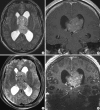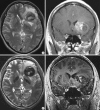Early experience of pre- and post-contrast 7.0T MRI in brain tumors
- PMID: 24015044
- PMCID: PMC3763113
- DOI: 10.3346/jkms.2013.28.9.1362
Early experience of pre- and post-contrast 7.0T MRI in brain tumors
Abstract
We investigated the safety and clinical applicability of 7.0 Tesla (T) brain magnetic resonance imaging (MRI) in patients with brain tumors. Twenty-four patients with intraaxial or extraaxial brain tumors were enrolled in this study. 7.0T MRIs of T2*-weighted axial and T1-weighted coronal or sagittal images were obtained and compared with 1.5T brain MRIs. The T2*-weighted images from 7.0T brain MRI revealed detailed microvasculature and the internal contents of supratentorial brain tumors better than that of 1.5T brain MRI. For brain tumors located in parasellar areas or areas adjacent to major cerebral vessels, flow-related artifacts were exaggerated in the 7.0T brain MRIs. For brain tumors adjacent to the skull base, susceptibility artifacts in the interfacing areas of the paranasal sinus and skull base hampered the aquisition of detailed images and information on brain tumors in the 7.0T brain MRIs. This study shows that 7.0T brain MRI can provide detailed information on the intratumoral components and margins in supratentorial brain tumors. Further studies are needed to develop refined MRI protocols for better images of brain tumors located in the skull base, parasellar, and adjacent major cerebrovascular structures.
Keywords: 7.0 Tesla; Brain Neoplasms; Clinical Applicability; Magnetic Resonance Imaging; Safety.
Conflict of interest statement
The authors have no conflicts of interest to disclose.
Figures






Similar articles
-
A case report of preoperative and postoperative 7.0T brain MRI in a patient with a small cell glioblastoma.J Korean Med Sci. 2014 Jul;29(7):1012-7. doi: 10.3346/jkms.2014.29.7.1012. Epub 2014 Jul 11. J Korean Med Sci. 2014. PMID: 25045237 Free PMC article.
-
Magnetic resonance imaging of hyaline cartilage defects at 1.5T and 3.0T: comparison of medium T2-weighted fast spin echo, T1-weighted two-dimensional and three-dimensional gradient echo pulse sequences.Acta Radiol. 2005 Feb;46(1):67-73. doi: 10.1080/02841850510012625. Acta Radiol. 2005. PMID: 15841742
-
Water excitation MPRAGE: an alternative sequence for postcontrast imaging of the abdomen in noncooperative patients at 1.5 Tesla and 3.0 Tesla MRI.J Magn Reson Imaging. 2008 May;27(5):1146-54. doi: 10.1002/jmri.21346. J Magn Reson Imaging. 2008. PMID: 18425826
-
Magnetic resonance imaging of thymic epithelial tumors.Crit Rev Diagn Imaging. 1996 Aug;37(3):191-259. Crit Rev Diagn Imaging. 1996. PMID: 8872410 Review.
-
The advantage of high relaxivity contrast agents in brain perfusion.Eur Radiol. 2006 Nov;16 Suppl 7:M16-26. doi: 10.1007/s10406-006-0192-3. Eur Radiol. 2006. PMID: 18655263 Review.
Cited by
-
First Application of 7-T Magnetic Resonance Imaging in Endoscopic Endonasal Surgery of Skull Base Tumors.World Neurosurg. 2017 Jul;103:600-610. doi: 10.1016/j.wneu.2017.03.088. Epub 2017 Mar 27. World Neurosurg. 2017. PMID: 28359922 Free PMC article.
-
The evolving role of neurological imaging in neuro-oncology.J Neurooncol. 2014 Sep;119(3):491-502. doi: 10.1007/s11060-014-1505-3. Epub 2014 Aug 1. J Neurooncol. 2014. PMID: 25081974 Review.
-
Comparison of 3 and 7 Tesla Magnetic Resonance Imaging of Obstructive Hydrocephalus Caused by Tectal Glioma.Brain Tumor Res Treat. 2016 Oct;4(2):150-154. doi: 10.14791/btrt.2016.4.2.150. Epub 2016 Oct 31. Brain Tumor Res Treat. 2016. PMID: 27867929 Free PMC article.
-
Use of a Commercial 7-T MRI Scanner for Clinical Brain Imaging: Indications, Protocols, Challenges, and Solutions-A Single-Center Experience.AJR Am J Roentgenol. 2023 Dec;221(6):788-804. doi: 10.2214/AJR.23.29342. Epub 2023 Jun 28. AJR Am J Roentgenol. 2023. PMID: 37377363 Free PMC article.
-
Radiomics-driven neuro-fuzzy framework for rule generation to enhance explainability in MRI-based brain tumor segmentation.Front Neuroinform. 2025 Apr 17;19:1550432. doi: 10.3389/fninf.2025.1550432. eCollection 2025. Front Neuroinform. 2025. PMID: 40313917 Free PMC article.
References
-
- Van der Kolk AG, Hendrikse J, Zwanenburg JJ, Visser F, Luijten PR. Clinical applications of 7 T MRI in the brain. Eur J Radiol. 2013;82:708–718. - PubMed
-
- Moenninghoff C, Maderwald S, Theysohn JM, Kraff O, Ladd ME, El Hindy N, van de Nes J, Forsting M, Wanke I. Imaging of adult astrocytic brain tumours with 7 T MRI: preliminary results. Eur Radiol. 2010;20:704–713. - PubMed
-
- Pinker K, Noebauer-Huhmann IM, Stavrou I, Hoeftberger R, Szomolanyi P, Weber M, Stadlbauer A, Grabner G, Knosp E, Trattnig S. High-field, high-resolution, susceptibility-weighted magnetic resonance imaging: improved image quality by addition of contrast agent and higher field strength in patients with brain tumors. Neuroradiology. 2008;50:9–16. - PubMed
-
- Strzhizhovskĭ AD, Galaktionova GV. Proliferation of bone marrow cells upon exposure to constant magnetic fields of ultra-high strength. Tsitologiia. 1978;20:717–720. - PubMed
Publication types
MeSH terms
LinkOut - more resources
Full Text Sources
Other Literature Sources
Medical

